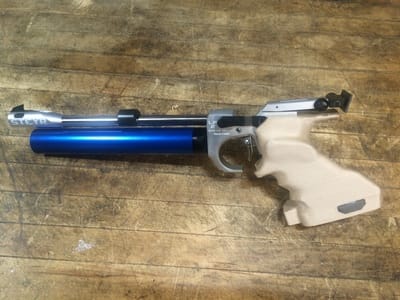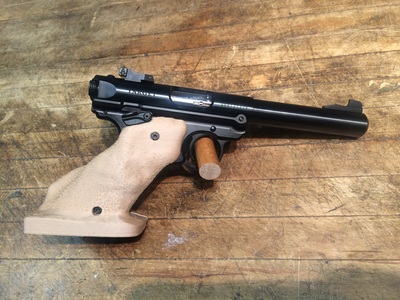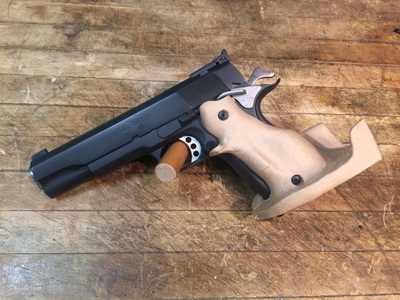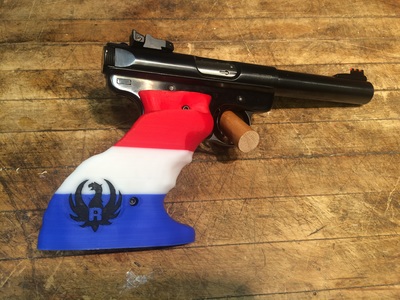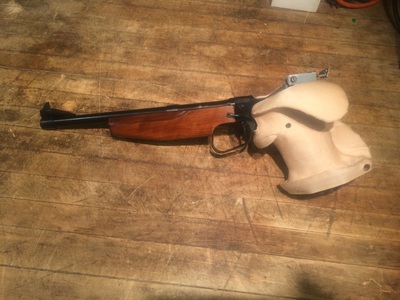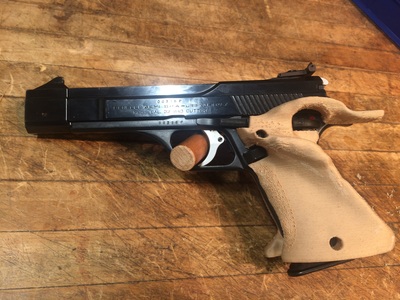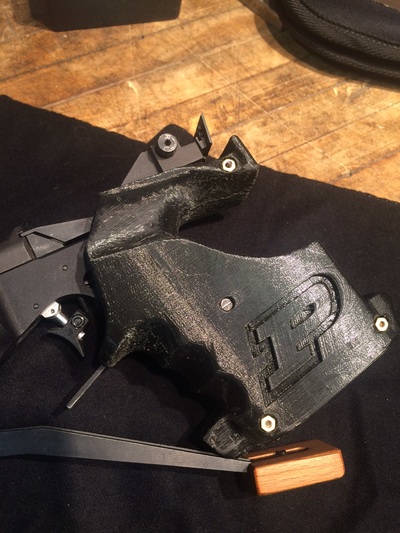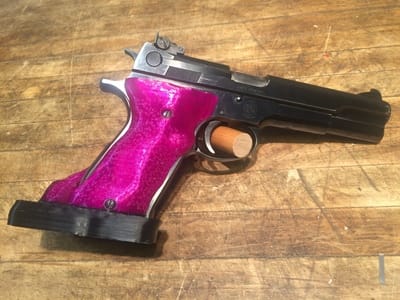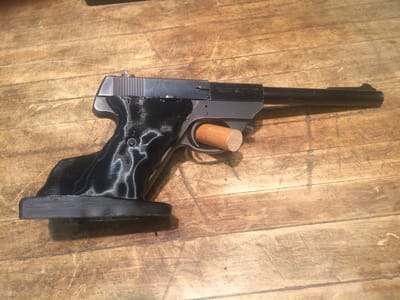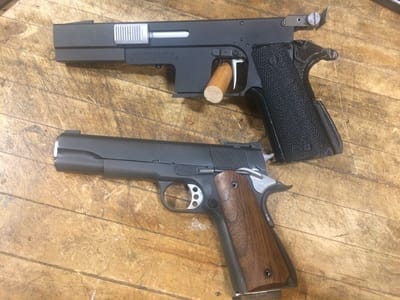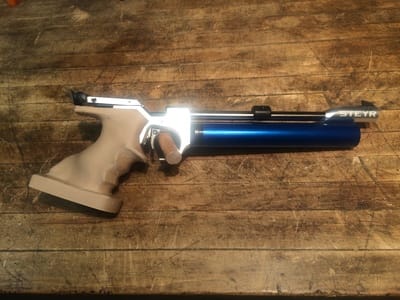Things to consider for your new grip
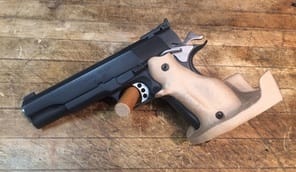 Most grips can considered as having either a European grip angle as at the top, or an American-style angle as with this 1911
Most grips can considered as having either a European grip angle as at the top, or an American-style angle as with this 1911
Some people ordering their grips know exactly what they want from the start. They either have a grip they already love and want reproduced, or they have held a friend's or saw a picture of what they're after. But others need to consider their options. This page is to help you understand what those options are. To watch a short video of how measure for your custom grip click here.
I suggest as you start this exploration to know two things. First, is your grip going on a gun with a grip-fed magazine (like a 1911 or Buckmark), or does the gun 's grip only contain a bottom attaching grip screw (like a Styer or Pardini)? If you like shooting with a cocked wrist like a Pardini, Steyr, or most European higher-end pistols, transferring that grip feel to a gun like a 1911 is a challenge. It can be done for a larger hand with acceptable results, but is all but impossible with a small hand due to the frame of the gun not allowing any movement. The opposite (placing an American-style grip angle on a European gun) however can easily be accomplished regardless of hand size.
The second issue to understand is what, if any, competitions you plan to shoot with your gun and grip. If you plan to shoot any ISSF (International) matches, then your grip must conform to some very specific dimensional and shaping requirments. Most notably the grip cannot exceed 50 mm and have no upsweep on the palm shelf. For shooter with a large hand this generally means they need to choose between either some small width on the palm shelf or a minimal thumb shelf. Both are not an option to stay within 50 mm for all but the most petite shooters. If however you only shoot NRA matches, then the rules are not as stringent. Grips do not have a width requirement and the palm shelf upsweep (as on the 1911 above), is allowed.
Most shooters prefer grips in one of three available colors of wood composite (black ebony, walnut brown, and cherry brown). This material is a blend of wood fiber and a non-petroleum-based polymer called PLA. While the wood composite grips won't be confused a fine piece furniture-grade English walnut, the grip really does feel like wood in your hand and has a nice matte finish. And during a match with hands starting to get a bit sweaty, this is an important consideration. If you don't require the wood feel on your grip, my default material otherwise is a black PLA. For customers wishing for a specific special color, PLA is also available in hundreds of different colors with translucent and pearlescent options available as well. The wood composite materials are more expensive than PLA due to their higher source cost and greater hand-work required post-printing.
Beyond this issues above, grip shapping options are generally a matter of personal preference. The digital modeling process used by Precision Target Pistol Grips allows the customer to view digital renderings of exactly what their grip will look like prior to production and make any changes desired. Options to consider include but are not limited to an upsweep on the palm shelf, finger grooves, width and angle adjustmensts on the thumb shelf, palm swell adjustments and so on.
Customers can either choose a basic grip shape from any of the grips shown on this site, send an email picture or description of the grip that inspires what they want, or speficy a combination of the two.
I suggest as you start this exploration to know two things. First, is your grip going on a gun with a grip-fed magazine (like a 1911 or Buckmark), or does the gun 's grip only contain a bottom attaching grip screw (like a Styer or Pardini)? If you like shooting with a cocked wrist like a Pardini, Steyr, or most European higher-end pistols, transferring that grip feel to a gun like a 1911 is a challenge. It can be done for a larger hand with acceptable results, but is all but impossible with a small hand due to the frame of the gun not allowing any movement. The opposite (placing an American-style grip angle on a European gun) however can easily be accomplished regardless of hand size.
The second issue to understand is what, if any, competitions you plan to shoot with your gun and grip. If you plan to shoot any ISSF (International) matches, then your grip must conform to some very specific dimensional and shaping requirments. Most notably the grip cannot exceed 50 mm and have no upsweep on the palm shelf. For shooter with a large hand this generally means they need to choose between either some small width on the palm shelf or a minimal thumb shelf. Both are not an option to stay within 50 mm for all but the most petite shooters. If however you only shoot NRA matches, then the rules are not as stringent. Grips do not have a width requirement and the palm shelf upsweep (as on the 1911 above), is allowed.
Most shooters prefer grips in one of three available colors of wood composite (black ebony, walnut brown, and cherry brown). This material is a blend of wood fiber and a non-petroleum-based polymer called PLA. While the wood composite grips won't be confused a fine piece furniture-grade English walnut, the grip really does feel like wood in your hand and has a nice matte finish. And during a match with hands starting to get a bit sweaty, this is an important consideration. If you don't require the wood feel on your grip, my default material otherwise is a black PLA. For customers wishing for a specific special color, PLA is also available in hundreds of different colors with translucent and pearlescent options available as well. The wood composite materials are more expensive than PLA due to their higher source cost and greater hand-work required post-printing.
Beyond this issues above, grip shapping options are generally a matter of personal preference. The digital modeling process used by Precision Target Pistol Grips allows the customer to view digital renderings of exactly what their grip will look like prior to production and make any changes desired. Options to consider include but are not limited to an upsweep on the palm shelf, finger grooves, width and angle adjustmensts on the thumb shelf, palm swell adjustments and so on.
Customers can either choose a basic grip shape from any of the grips shown on this site, send an email picture or description of the grip that inspires what they want, or speficy a combination of the two.
